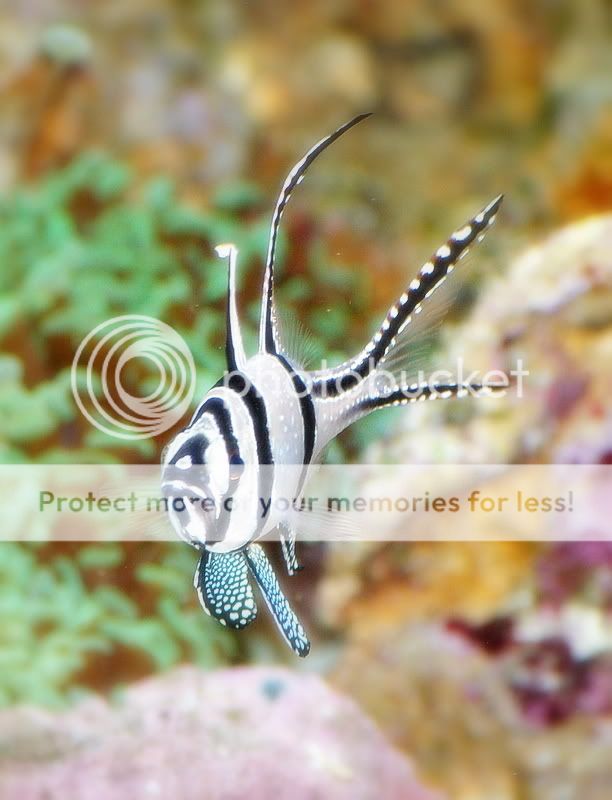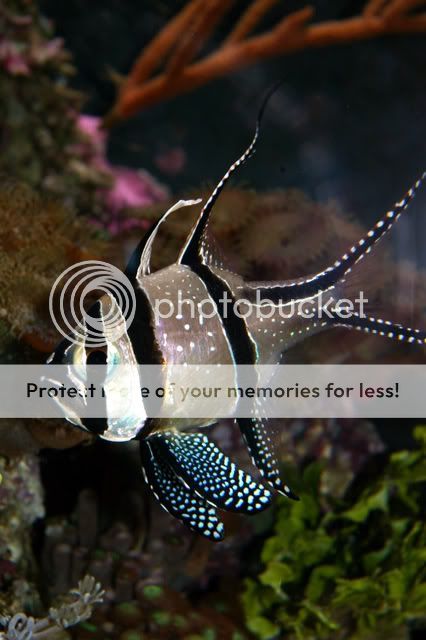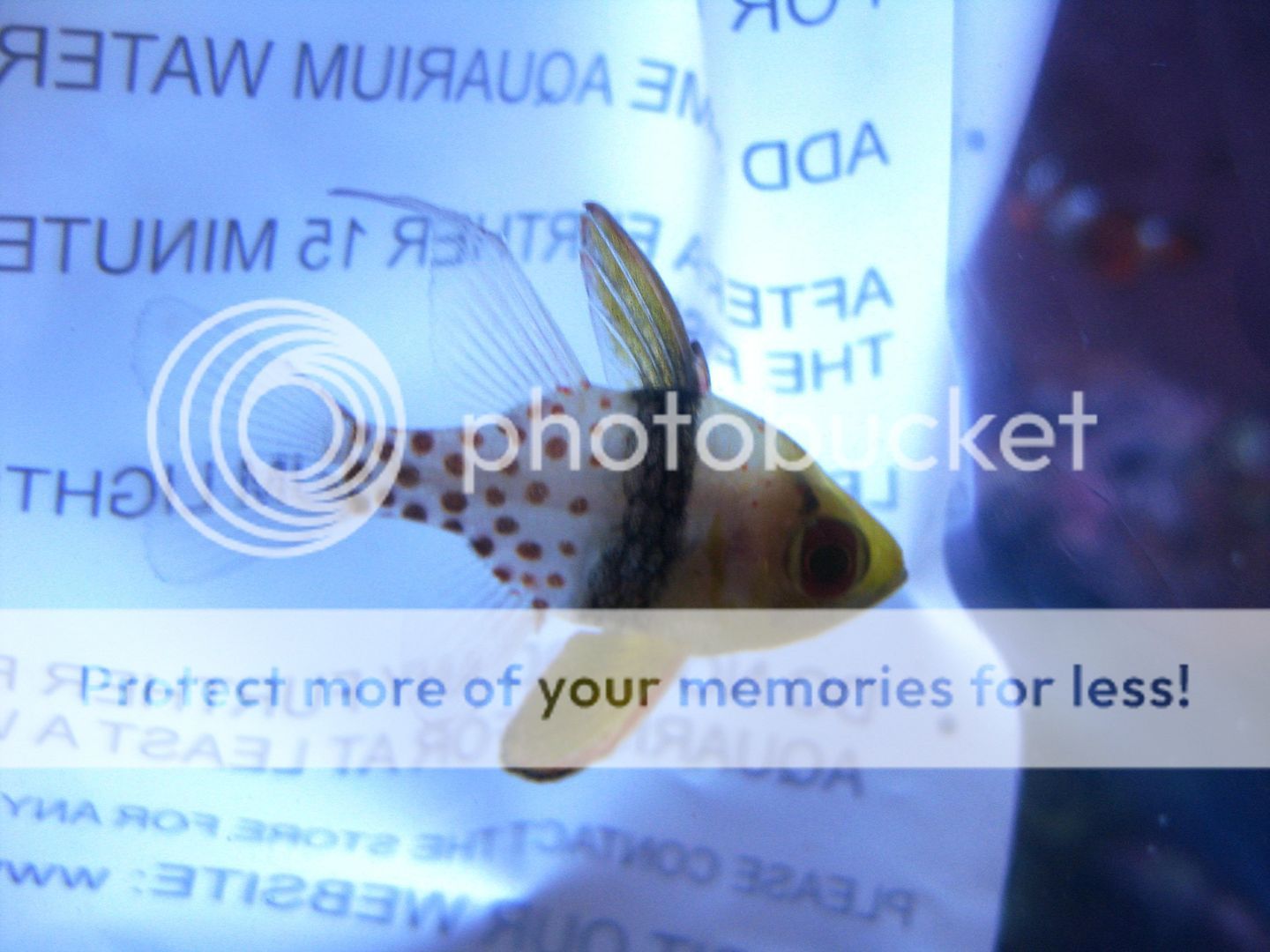What does Bob Fenner have to say on the subject of Cardinalfish?
It's a shame that Cardinalfishes are so often passed over as marine aquarium specimens. It's my guess that their odd-shapes, retiring conduct, and large, all-seeing eyes must lead aquarists to consider this group as being too 'touchy' for captive use. Admittedly, the success rate in keeping these fishes is dismal; but for explainable, correctable reasons.
Cardinalfishes occupy some of the same niches on the reef and in aquariums as the damsels (family Pomacentridae); biologically, they're principal forage fishes for piscivores; commercially they're plentiful, easily captured, and transport well; resulting in their being relatively inexpensive to acquire.
Securing decent specimens, maintaining them in a small school, and granting them a few provisions will reward you with hardy, interesting and long-term specimens.
Systematics:
Cardinalfishes, family Apogonidae ("Ap-oh-gahn-id-ee") are members of the largest Order of fishes, the Perciformes. They are one of the largest families of fishes with about 27 genera and 250 species. The Cardinals are further subdivided into two families (the deepwater Epigonidae) and sub-families depending on whose taxonomic scheme you favor. Hobbyists are generally offered a half dozen members of the largest genus Apogon and the Pajama (S. orbicularis) and Blackbelt Cardinals of the genus Sphaemeria.
Many Cardinalfishes are reddish in color (hence their common name) mixed with silver and white, though most species are yellow, silvery and black. All have large eyes, and are nocturnal; hiding in crevices or beneath ledges by day (typically with Squirrelfishes, bigeyes and sweepers). These are mostly shallow water fishes, found from the surface to about 100 meters.
Pterapogon kauderni Koumans 1933, the Banggai Cardinalfish. Restricted in distribution to Banggai Island, Indonesia, though commercially produced in good numbers in Indonesia and elsewhere. To three inches in length. A darling of the ornamental aquatics industry and hobby. Readily reproduced in captivity. Young cluster about the spines of the Urchin Diadema setosum when threatened
Size:
Most to a few inches, some species to six-eight inches or more in the wild.
Selection:
Cardinals display little middle-ground in their quality on-arrival; they are either hardy and sure to "make it", or thrashed and "doomed" to break down and die. For reference, they share many of the same selection criteria as damselfishes.
1) Behaviorally; look closely at the group on display. They should be clustered somewhat, with none having "private parties" off in the corners of the system. Are they aware of your presence? Good.
2) Reddening: Examine the bodies of each specimen carefully, especially the insertions of unpaired fins. Do you see evidence of infection on any individual? If so, pass them by.
Environmental: Conditions
Habitat
Cardinals hide in the netherworld of ledges and corals by day; searching the bottom for food, by night.
Chemical/Physical
Apogonids are about as tolerant as damselfishes; they are not demanding. Some temperate species prefer lower temperatures, but 72-78 degrees F. is fine for the group as a whole. Elevated temperatures may bring on a feeding strike and odd behavior. Higher, steady specific gravity is appreciated, closer to 1.025; maybe due to their close association with invertebrates?
Cardinals will tolerate a few tens of ppm of nitrate, but little or no ammonia, nitrite.
Biology/Other
I'd like to mention that apogonids are an under-rated portion of the living reef's populations. Several of the hundreds of species are of large number in the wild, just not commonly encountered due to their largely nocturnal habits. Many form close associations with invertebrates, living within the spiny shelter of urchins, sea stars and more.
Filtration
I'd shy on making it brisk. These fishes are found in areas where the water really whips at times.
Display
For a really outstanding arrangement, provide a large dark shelter-space with one opening and a group of these fishes and others they are found with in the wild. The under ledge and cover sub-habitat is a rich biotope in the reef world.
Behavior:
Territoriality
Generally not. In the wild most live in aggregations as young and adults. In captivity they only fare well in groups.
Introduction/Acclimation
Best put in established systems, keeping some low illumination on but subdued for a couple of days.
Predator/Prey Relations
Most cardinalfishes as individuals get along with their own kind, other species of apogonids and other peaceful tankmates. Large predatory fishes will inhale them like so much aqua-popcorn if they're small enough.
The smaller species (some get to six inches) are strongly promoted for use in fish-only and reef-tank set-ups. They are supreme choices, being hardy and interesting; their only shortcomings being that they're shy and reclusive. Apogonids as a rule do not "sample" more than mouth-size invertebrates.
Reproduction, Sexual Differentiation/Growing Your Own:
Several species spawning habits are known. The sexes are not much differentiated but may be distinguished by the males slightly larger size and the girth of gravid females. They are some of the few marine mouthbrooders with the males generally doing the incubating. Young are released after about a week, and develop as plankton for a couple of months in the upper water column.
Feeding/Foods/Nutrition:
Apogonids are predators on small very small fishes and mobile invertebrates, principally crustaceans. Livebearers, shrimp and other fresh and frozen meaty foods are acceptable and good starter foods to train them onto frozen processed foods; avoid pellets, flake and other dry prepared foods; these will not sustain them.
If your specimens are new, refusing food, or go on a feeding strike, execute a large water change and try some live brine shrimp with the lights off on the system.
Disease: Infectious, Parasitic, Nutritional, Genetic, Social
These fishes are generally received external parasite free, and clean up easily with routine freshwater dips and quarantine. The usual protozoan scourges of tropical marine fishes can be handily defeated if detected early enough with standard copper remedies.
Summary:
Don't let the apogonids secretive, nocturnal behavior or odd appearance dissuade you from trying them. They are good aquarium specimens, whose only demands are dark shelter, meaty foods and the society of other members of their species.
Bob Fenner
 )
) )
)










